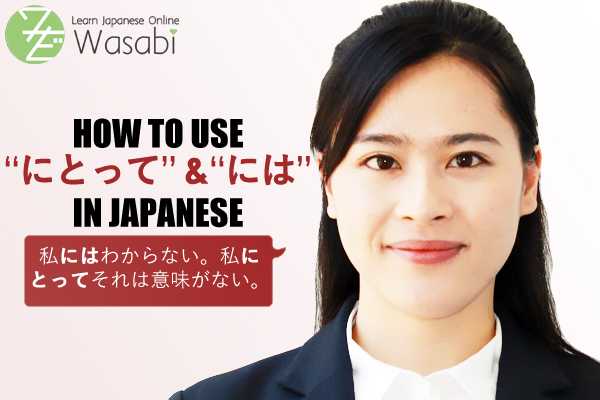How to use the particles “は”, “にとって”, & “には” in Japanese
Welcome back to our “Video & Article” series with tutor Miki. In this article and video, Wasabi Japanese tutor Miki teaches more in-depth aspects of the topic marker particle “は”. Miki introduces the particle combination “には”, and the very similar expression “にとって” and how to use each expression as well as what their differences are. This is a great read for Japanese learners of all levels!
| Table of Contents [Introduction] [Particle は: Quick review] [Particle: には] [Particle: にとって] [Comparing は, には, & にとって] |
[Introduction]
In the last session, we went over the similarities and differences between the particles “に” and “へ”. In this lesson, we will continue talking about particles – we will return to the particle and topic marker “は”. We will take a look at the particle combination “には”, and the particle and verb combination “にとって” which has a very similar meaning.
[adsense]
[Particle は: Quick review]
As we have learned before, the particle “は” is used as a topic marker in Japanese. One other key aspect of “は” is that it is often used for comparisons or contrasting statements. This can be a bit confusing, since the comparison or contrast is often not specifically stated.
For example:
頭が痛い時はこの薬を飲んでください。
Please use this medicine in case you get a headache.
“頭が痛い時” is followed by the particle は, so “頭が痛い時” (The case of your head hurting) is marked as the topic. The implication here is that there is a contrast between the case when your head hurts and when it does not.
So “Compared to the time when you don’t have a headache, please take this pill in case you do have a headache.”
[Particle: には]
So how would you use “には”, a combination of the particles に and は? には is used to emphasize parts of a sentence.
As mentioned before, は is used for comparisons and contrasting a part of a sentence. Let’s use the example sentence from before, but use には instead this time:
頭が痛い時には、この薬を飲んでください。
Please take this medicine only when you have a headache.
The phrases convey nearly the same being, but this sentence puts more emphasis and restriction around the condition described before には. So this emphasizes that you should only take this medicine in case of a headache.
には strictly limits its the part of the sentence that comes before it, since it combines the topic marker は with に, which determines times and places. Another good example is:
君の行動が私には意味がわからない。
I don’t understand your behaviour.
In this sentence, 私 (I) stands before には, so the content following には only applies to 私 and nobody else. You could also translate the above sentence as “Others may be to understand you, but I don’t understand your behaviour”.
[Particle: にとって]
“にとって” is a combination of the particle “に” and the verb “とる”, and combined it means “from the point of view of…”, or more simply “for…” or “to…”. にとって is usually followed by some kind of judgement: good or bad, meaningful or meaningless, useful or useless.
For example:
このオルゴール捨ててもいい?
Can I throw away this music box?
だめ!それは私にとってとても大切なもの。
No! That is a very precious thing to me.
[Comparing は, には, & にとって]
Let’s make the differences between は, には, and にとって clearer by using an exercise. Please look at the following three sentences and choose one of the three particles: は, には, or にとって:
① 私( は/には/ にとって)あのやり方には反対です。-hint: disagree with method
② 私( は/には/ にとって)あのやり方は全く理解できない。-hint: don’t understand the method at all
③ 私( は/には/ にとって)あのやり方は全く意味がない。-hint: meaningless method
Correct answers:
① The correct choice is は; にとって is not applicable because there is no evaluation/judgement and since には is used at a different part in the same sentence, you usually wouldn’t use the same particle twice to avoid repetition and choose は.
私はあのやり方には反対です。
As for me, I disagree with this method.
② The correct choice is には; again, the meaning (not understanding something) is not an evaluation, and は is already used in another part of the sentence, so the only option here is には.
私には、あのやり方は全く理解できない。
I personally do not understand this method at all.
③ The correct choice is にとって; “意味がない” (meaningless) is an evaluation and judgement made by the speaker.
私にとって、あのやり方は全く意味がない。
To me, this method is meaningless.
That’s everything for today. Thank you for reading this article, and please feel free to consult our native Japanese language teachers if you have any further questions!
| 復習する | To review |
| 助詞 | Particle |
| 場所 | Place, location |
| 語彙 | Vocabulary |
| 強調する | To emphasize |
| 薬 | Medicine |
| 行動 | Action, conduct, behaviour |
| 意味 | Meaning |
| オルゴール | Music box |
| 捨てる | To throw away |
| 大切 | Important, valuable |
| やり方 | Method, manner of doing |
| 反対 | Opposition, resistance |
| 理解 | Understanding, comprehension |

The Difference Between the Particles “に” and “へ”

How to Communicate Non-Verbally in Japanese


